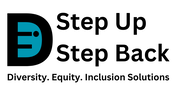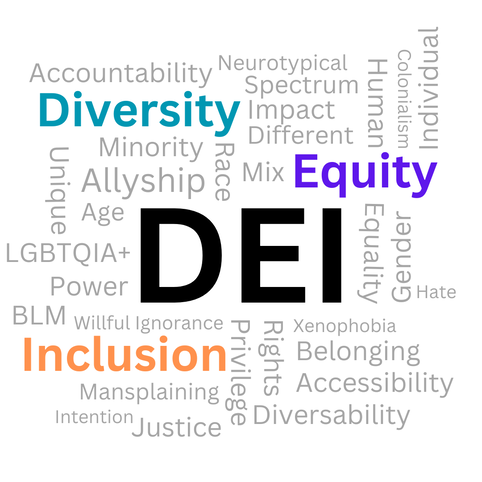DEI Is More Than Just A BuzzwordThe acronym DEI is one of the trendiest professional terms among professional leaders and organizations today, but this key term is often misinterpreted. This article will define the acronym DEI, explain the high value of DEI, and recommend beginning DEI steps for leaders. You have probably heard or read about the term at least once in the past 24 hours in relation to current events in the news or at work. DEI has finally gained popularity with mainstream professional practices despite its principles predating the establishment of major corporations. Current events including the Covid-19 pandemic, Black Lives Matter, anti-Asian hate, and trans rights have pushed DEI to the spotlight of American society. In response to the increasing visibility of minority rights, there is a greater demand for higher standards of leadership accountability through DEI. What does DEI mean?In the USA the acronym DEI stands for diversity, equity, and inclusion. These three components are the foundational principles for all DEI work regardless of geographic location. For example, in the United Kingdom DEI is referred to as EDI. Below are a few variations of the American English term DEIBA - Diversity, equity, inclusion, belonging, accessibility JEDI - Justice, equity, diversity, and inclusion DI - Diversity and inclusion EDI - Equality, diversity, and inclusion There is no “right way" to go about DEI because it is a full spectrum of ongoing processes rather than a linear approach. DEI is not about black and white finite judgment. DEI operates in black, white, and all shades of gray. With that said, please pay attention to the order of the acronym because no one wants to participate in social justice work labeled DIE. DIVERSITY is defined as a mix of many different ideas, beliefs, and experiences. It is the opposite of being the same and homogenous. Diversity includes and is not limited to protected identities such as race, gender, age, diversability (disability), sexual orientation, and religion. EQUITY is defined as support based on different needs to increase access. In contrast, equality is defined as the same support given to all. An example of equality is giving everyone the same apple to eat. Each person gets the same size, shape, and colored apple. This same treatment is applied to meet the basic biological need for humans to eat for survival. Equity acknowledges the biological need to eat for survival and offers support with improved accessibility to eat the apple. For example an equitable option would be to give a baby applesauce because they have no teeth. Another example of equity would be to give a person with braces or dentures either a knife to cut the apple into smaller pieces or provide pre-cut bite sized apple pieces. Equity and equality do not mean the same thing and are often misinterpreted as interchangeable buzzwords. INCLUSION is defined as being respected, supported, and valued as an individual. Inclusion is not about conforming to the dominant culture. Inclusion occurs when safe space is created to maintain individualism. When individuals feel safe they bring their unique talents, strengths, and knowledge to a larger group resulting in a stronger community. Why DEI is a big deal
How does a leader start DEI?The first step begins with yourself as an individual and as a leader. An active leader interested in DEI should begin by self assessing their ability and willingness to engage with DEI. Below are guiding questions to self assess:
The second step is to build a robust team of DEI specialists informed by the answers above. DEI is created through behavior change. Behavior change occurs through the learning and application of new ideas, tools, and frameworks. Continually do research to learn the best DEI practices and services offered by DEI professionals to add to your organization's shared pool of knowledge. Seek a balance of DEI professionals with both informal and professional DEI experience/credentials. Be equitable and intentional about hiring DEI material specialists with lived DEI experiences as self-identifying members of minority communities. The third step is to stick to it and follow through. DEI work is hard because it directly addresses root issues of power imbalance within organizations and their leaders. Impactful DEI work typically addresses identity, language, and philosophy, which can be perceived as personal attacks on individuals when viewed with a closed mind. DEI work seeks to call in rather than call out. Calling out identifies the issue and problematic behaviors. Calling in identifies the issue, problematic behaviors, and offers resources to overcome exclusive and discriminatory barriers. The key takeaway from this article is an improved understanding of DEI as a term, its value in the professional world, and beginning DEI steps for leaders. Remember a single superior form of DEI does not exist. DEI is a collaborative ongoing body of work that is a spectrum of experiences, ideas, and beliefs. Leaders who align their work with the three main principles of diversity, equity, and inclusion will be able to maintain focus and forward progress towards organization-wide DEI behavior change. This work demands commitment, authenticity, and humility from all who participate. In the larger scope of professional development DEI is one of the highest levels of leadership accomplishments due to its complexity and level of difficulty. Best of luck to the DEI leaders of today and tomorrow! Nifee debiru (Thanks) for reading till the end! I hope this article helped clarify common DEI terms and point leaders in the right direction to begin their DEI work. Please comment and share this with anyone who might benefit from the information. If you have questions please don’t hesitate to contact us at [email protected]. References Dawkins, Ryan(2019). One American Identity, Two Distinct Meanings. University of Colorado Boulder. https://www.colorado.edu/center/benson/western-civilization/summer-institute/summer-institute-essays/one-american-identity-two-distinct. Quick Facts United States. United States Census Bureau.. Retrieved April 5, 2023, from https://www.census.gov/quickfacts/fact/table/US/PST045221. The Crucial Learning Glossary. Crucial Learning. Retrieved April 5, 2023, from https://cruciallearning.com/glossary/#:~:text=When%20two%20or%20more%20people,the%20better%20the%20decisions%20made.
1 Comment
RPJ
4/6/2023 06:59:51 pm
DEI or DIE! Sad to say that organizations and companies that don't embrace DEI are going to be left behind as their competitors better align with their customer's requirements and able to attract and retain the best talent to assure prosperity. DEI is not a fad. It is an investment that will take time to realize the long term benefits.
Reply
Leave a Reply. |
Learn & ExploreBlog posts to expand your leadership knowledge and increase your exposure to DEI Archives
June 2024
Categories |
Proudly powered by Weebly


 RSS Feed
RSS Feed